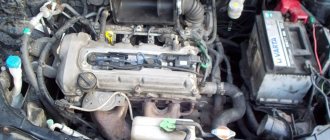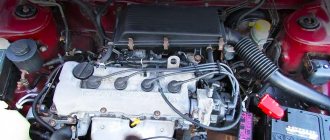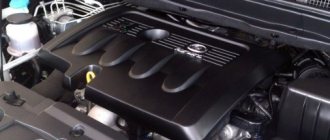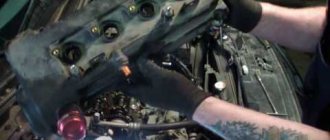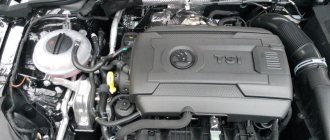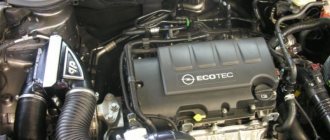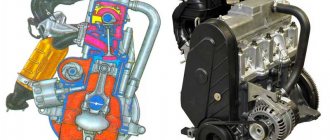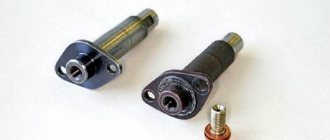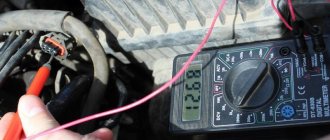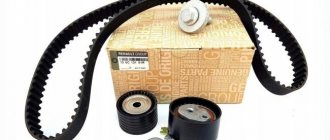This review is dedicated to the Suzuki Grand Vitara 2008, in which we will look at the body and interior, the technical characteristics of the car, as well as the engine size and fuel consumption of the Suzuki Grand Vitara 2008. Back in 1997, when Suzuki introduced the successor to the Vitara - a model with the resounding Grand prefix, this car has impressed many. The Grand Vitara inherited from its ancestor a frame chassis design and all-wheel drive with a rigidly connected front axle (without a center differential) and a two-speed transfer case. It was a real compact SUV, which, moreover, felt very good on the asphalt.
Years passed, the next generation of the model debuted, the frame structure was replaced by a monocoque body with an integrated frame, and the connected front axle was replaced by permanent 4x4 all-wheel drive. In addition to the downshift range, the crossover was equipped with a cross-axle differential lock. It was a completely different car.
Appearance Suzuki Grand Vitara 2008
However, this is already the past. Today Suzuki introduces an updated version of the third generation Grand Vitara. The main changes affected the engine line , which is why three cars were displayed for journalists at a test drive held in the vicinity of St. Petersburg.
The range of power units offers a choice of 4-cylinder petrol engines with an electronic injection system with a volume of 1.6 and 2.0 liters and a power of 94 and 128 hp. respectively. Plus a 2.5 liter V-shaped 6-cylinder engine producing 144 hp. For the extended 7-seater in the Grand Vitara, there was also a more powerful 173-horsepower V6 2.7 engine - a version of the already famous 2.5-liter “six”.
If until recently, 5-door Grand Vitars were sold only with a 140-horsepower two-liter engine, now more powerful units have become available: 2.4 liters, with a capacity of 168 hp, and a top-end V-shaped “six”, producing 232 hp – it comes paired with a five-speed automatic transmission. The remaining engines, as on the new Subaru Forester, are combined with a leisurely 4-speed automatic transmission or 5-speed manual transmission. In addition, in all versions of the car, the rear drum brakes were converted to disc brakes.
Yes, the third generation Suzuki Grand Vitara is no longer the purebred and uncompromising compact frame SUV that we knew it before. However, the designers of the new model assure that, despite the integrated frame and independent multi-link rear suspension, the Suzuki Grand Vitara has not lost any of its off-road capabilities.
The transmission control has four modes : N – neutral (the wheels are disconnected from the engine, the car can be towed), 4H – permanent all-wheel drive (main mode), 4HLock – all-wheel drive with a locked center differential and 4Lock – all-wheel drive with a locked center differential and low gear . Note that the 4HLock mode can be activated at speeds up to 100 km/h, but only in off-road conditions (or on surfaces with a low coefficient of adhesion), and to activate the 4Lock mode you must stop.
What's behind all these off-road goodies? First of all, the manufacturers have tried to equip the car with a variety of electronic and mechanical systems that make driving easier in difficult road conditions. So, when driving on snow, mud, etc. - in a word, on off-road surfaces, it is enough to move the automatic transmission lever to mode “3”, “2” or “L” - the lowest speed. If this is not enough, you can limit the vehicle speed to ten kilometers per hour by setting the 4H Lock mode. In this case, the torque will be transferred, depending on driving conditions, to different wheels of the same axle. This will also help if one of the wheels is hanging on the axle. When this is not enough, you can use the 4L Lock forced transmission mode. The car will begin to move at a forced low speed, but a huge torque will be transmitted to the wheels, which will allow you to successfully pass through V-shaped passages, coping with situations when the wheels periodically hang in the air, not even one by one, but two at a time.
There are also auxiliary electronic “assistants” : the Hill Descent Control system and its inverse Hill Hold Control system, which holds the brake for another two seconds when the driver’s foot is already placed on the gas pedal, preventing unwanted rollback of the car.
Moreover, the first one is available only for version 3. But ESP “in the base”, as before, is not offered at all.
Engine oil for Suzuki Grand Vitara
On Suzuki GV car models, it is recommended to change the engine oil and oil filter every 15 thousand kilometers. If the car is operated in difficult conditions (frequent trips in off-road conditions, operation of the car at high speeds), maintenance should be performed more often (every 10 thousand km). The manufacturer recommends filling Suzuki engines with Suzuki Motor Oil type 0W-20; official dealers use Castrol 5W-30 for maintenance.
In frosty winter conditions, a thinner oil according to the SAE classification should be used; the 0W-20 oil type best meets these requirements. For engines G16B, H25A, H27A, F9Q, “synthetic” is recommended; for engines J20A and J24B it is better to fill in semi-synthetic oil. It is not recommended to fill in mineral water - the engine life may be noticeably reduced.
Each type of internal combustion engine requires a certain amount of motor oil; the filling capacities of Suzuki engines are as follows:
- G16B – 4.2 l;
- J20A – 4.5 l;
- J24B – 4.6 l;
- H25A – 5.5 l;
- H27A – 5.5 l.
The oil in the Suzuki Grand Vitara engine must meet quality requirements, and in order not to run into counterfeit products, you should only buy products from trusted retail outlets.
On J24B GV engines, changing the oil is quite simple; any driver can do the change. We carry out the work in the following order (on a pit or a lift):
- if the engine is cold, warm it up to operating temperature;
- prepare a canister of oil (in this case you will need 4.6 liters);
- immediately pour a little oil into the oil filter;
- unscrew the plug on the oil sump, drain the waste into a pre-prepared container;
- To get to the oil filter, remove the exhaust manifold casing;
- Using a puller, we dismantle the old oil filter and install a new filter element;
- fill in new engine oil according to the level;
- close the oil filler cap and start the engine.
Test drive Suzuki Grand Vitara 2008
Of course, depending on the engine installed, cars have different characters. A car equipped with a powerful “six” is simply heavier, and the Grand Vitara with a 2-liter low-revving engine and the most modest weight feels best off-road. On a straight line, the most powerful car takes the lead: the nameplate dynamics of 9.3 to hundreds versus almost 13.6 for a two-liter automatic transmission is a whole abyss... But it is more gluttonous, and in this sense, the “intermediate” version of 2.4 looks the most attractive - and dynamics decent, and the stated consumption of 12.5 in the city is a completely reasonable figure.
Thanks to the abandonment of the classic frame and the installation of completely independent suspensions both front and rear, the car feels confident on the asphalt. On the Ring Road it showed itself just as well as on the snow-covered hills: confidently, without yawing, it holds a straight line, easily maneuvering in traffic on wet asphalt. Vibrations on winter tires appear only at 120 km/h, but their cause can be easily read: studded tires and icy dirt stuck to the inside of the disc. By the way, the sound insulation has surprisingly improved in quality - the sand rustling along the arches is barely audible.
Changes in the updated Suzuki Grand Vitara affected not only the technical characteristics of the car, but also some design elements. During the facelift, the shape of the radiator grille and front bumper was adjusted, the huge side mirrors received double turn signals, and the color palette was replenished with new color options. Something has changed in the interior of the car. Thus, the information display was integrated into the dashboard, the climate control unit became more ergonomic, and one of the speakers “moved” to the top of the center console. New finishing materials have also appeared.
Is it worth buying, if so, with which engine?
After weighing all the pros and cons, most likely yes. Because there are few good, reliable, durable cars now. Manufacturers have not been interested in playing the long game for a long time. They need units, parts, mechanisms, and machines to be replaced more often with new ones. Suzuki Grand Vitara is not like that. There are many timeless classics here that will serve well for decades.
No turbocharged internal combustion engines, no robots, no CVTs - beautifully smooth and imperceptibly working hydromechanics with a long service life. The most important thing when purchasing a commercial vehicle is to avoid expensive repairs or frequent replacement of expensive items. If you choose this Japanese one, the price will be more than adequate.
Objectively, for a 5-door car, two liters and with passengers on a trip out of town and beyond will not be enough. Around the city, from work, home, to the shops - enough. Therefore, 2.4 liters with a power of 166 hp. - just right, and the 233 horses that the 3.2 liter produces is too much. For such power the car is light, it becomes dangerous, maneuverability is lost.
In general, the car is a real Japanese prude, which has everything you need to feel calm and safe on the road, to know and be confident, and not to guess, whether it will work or not on the off-road section. When creating the Grand Vitara, Suzuki did not waste time on creating a super-fashionable design, placing emphasis on the main thing.
Source
Salon Suzuki Grand Vitara 2008
However, it’s still a bit gloomy inside. The only truly successful element is the dashboard. Three dials in deep wells with optitron backlight set a sporty mood. But I don’t want to find fault: everything here is really ergonomic, the seats are ready to accommodate a rider of any size, compartments for small items are located throughout the cabin, and there is music control on the steering wheel...
The gallery can accommodate three adult passengers, but you won’t envy them on a long trip. The backrest of the split (60:40) rear sofa is adjustable in angle of inclination. The trunk is small (398 liters), but with the rear seats folded down the volume increases to 1396 liters. The traditional “Vitarov solution”: a full-size spare wheel in a stylish hard case is suspended on the hinged fifth door, thereby saving space in the luggage compartment. A car with such an “appendage” really looks like an SUV!
The Grand Vitara is one of Suzuki's most successful models, but the updated car will appeal not only to long-time fans of the brand. Having caught up with its counterparts, with new engines this car is able to displace such giants as the Toyota RAV4 and Subaru Forester, winning back part of the market niche from them. As for the cost of the car, it starts at a very competitive level of 832 thousand rubles (2.0, manual transmission) and reaches 1 million 190 thousand for a car in the maximum configuration. Read more…
